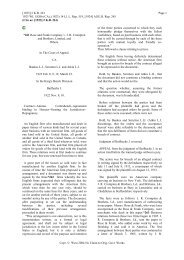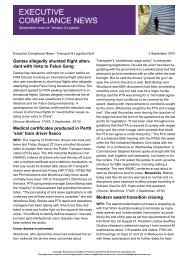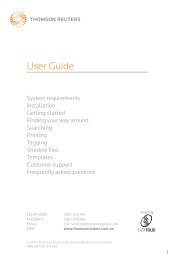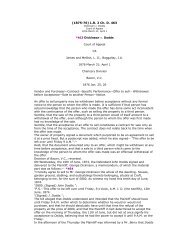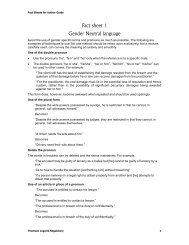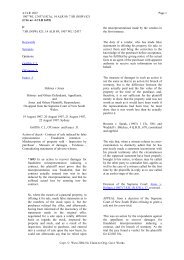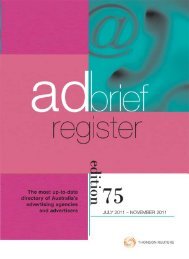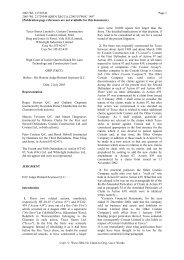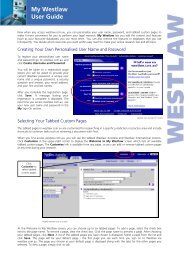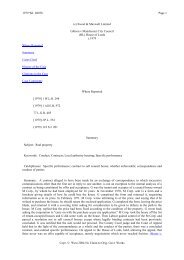Chapter 23: Product Liability - Thomson Reuters
Chapter 23: Product Liability - Thomson Reuters
Chapter 23: Product Liability - Thomson Reuters
You also want an ePaper? Increase the reach of your titles
YUMPU automatically turns print PDFs into web optimized ePapers that Google loves.
Strict <strong>Liability</strong> 158due to a faulty door latch. 207 But mere failure to discover the defect or riskyconduct which the design or warning should have prevented ought not to begiven much, if any, weight. 208Misuse of the product will provide a complete defence if unforeseeable, 209such as using a sharp knife as a toothpick or pouring perfume over a lightedcandle. 210 The Australian Consumer Law specifically directs that, indetermining “safety defect”, account must be taken of “what might reasonablybe expected to be done with or in relation to” the product. 211 The product mustbe proof, however, against foreseeable misuse so as, for example, to requirewarning against drugs or toxic household substances accessible to littlechildren. 212 Alterations of the product like dismantling of guards or other safetyfeatures would also preclude liability, because the defect would then not haveexisted at the time the product left the manufacturer. 213Producers and products[<strong>23</strong>.160] American law imposes strict liability on all commercial sellers of aproduct: manufacturers, intermediaries and retailers. 214 This stems from itsorigin in sellers’ warranties and is defended on the ground that the consumershould be free to select from whom to claim, leaving the ultimate allocation ofthe loss to the potential defendants. The UK statute, following theECDirective,confines liability to the producer, anyone who has held itself out as such, like“own-brand” suppliers, and any importer. 215 Other suppliers are exempt,unless they fail to identify on request anyone of the previously mentionedclass. 216 Curiously, belying the rhetoric of the reform, the classes mentioned,other than the producer, are the only ones to bear real strict liability, analogousto vicarious liability for the fault of another: here, the producer.The Australian Consumer Law is closer to the British position than theAmerican. The Law imposes liability not on all suppliers but on “amanufacturer” (s 138(1) (formerly s 75AD)); it includes importers if themanufacturer has no place of business in Australia (s 7(e) (formerly s 75AB))and suppliers who fail to identify the manufacturer (s 147 (formerly s 75AJ)).“Goods” are defined in the Australian Consumer Law to include: (a) ships,aircraft and other vehicles; (b) animals, including fish; (c) minerals, trees andcrops, whether on, under or attached to land or not; (d) gas and electricity; (e)DRAFT207 Daly v General Motors, 575 P 2d 1162 (Cal 1978).208 General Motors Corp v Sanchez, 997 SW 2d 584 at 594 (Tx 1999) (“Contributorynegligence of the plaintiff is not a defense when such negligence consists merely in a failure todiscover the defect in the product, or to guard against the possibility of its existence”). Seealso Rest 3rd: <strong>Product</strong>s <strong>Liability</strong>, s 17, cmt d.209 The Preamble of the European Council Directive 85/374/EEC speaks of misuse “notreasonable in the circumstances”.210 Moran v Faberge Inc, 332 A 2d 11 (CA Md 1975).211 AustralianConsumerLaw, s 9(2)(e) (formerlyTradePracticesAct1974 (Cth), s 75AC(2)(e)).212 See above, [<strong>23</strong>.70].213 Australian Consumer Law, s 142(a)(ii) (formerly Trade Practices Act 1974 (Cth),s 75AK(1)(a)).214 Rest 2nd, s 402A imposes on “One who sells any product in a defective conditionunreasonably dangers to the user or consumer …”215 European Council Directive 85/374/EEC Art 3(1), (2); Consumer ProtectionAct 1987 (UK),s 2(2).216 European Council Directive 85/374/EEC Art 3(3); Consumer Protection Act 1987 (UK),s 2(3).session: 5 October 28, 2010 page no: <strong>23</strong> folio no: 158@syd-tlrapp-p19/syd-tlrapp-p191/CLS_law/GRP_flemings/JOB_update10/DIV_19PROOF COPY



